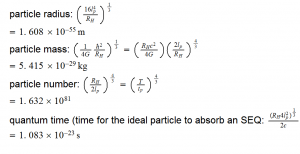Elementary particles are not static entities. Particles are dynamic, their energy, mass, radius, and time to absorb a quantum of energy change with time and expansion. Additionally, the number of elementary particles in the observable universe increases with time.
The key to working this out is the realization that there is an 'ideal particle'. The ideal particle mass is very close to the mass of elementary particles. The ideal particle radius is the geometric mean of the Compton radius of the ideal elementary particle. This is discussed at length in the Origin of Matter and Gravity paper. The following table gives the values for the mass, radius, quantum time, and number of ideal elementary particles that the universe appears to try to create:
Notice the presence of the term for the hyperverse radius in the equations. With time, the ideal particle's mass and radius decrease, and the number of particles increases. The quantum unit of time increases with expansion.
Particles are composed of the quanta of space. With expansion, the quanta of space are shrinking, and at a different rate than particles. Also, the angular momentum of the universe continually increases. This causes particles to continually accrete more quanta to continue to conserve angular momentum. This continuing accretion of the quanta of space, is gravity.
Particles of matter are NOT static units; elementary particles continually change with time and expansion.
